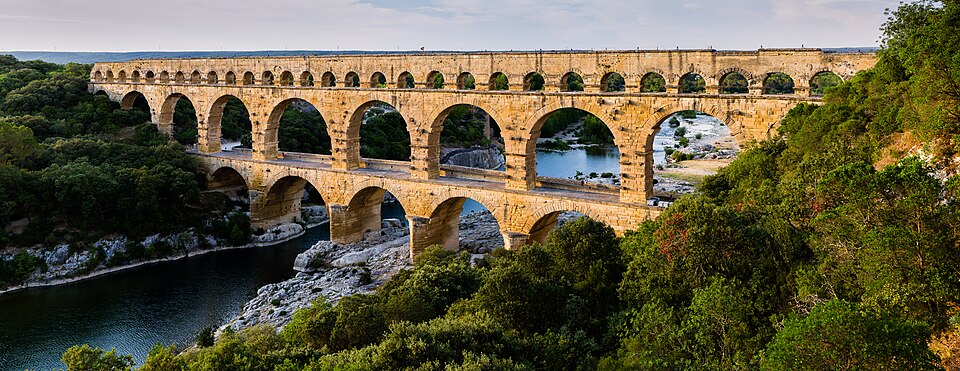
How did a Roman aqueduct work? An aqueduct works by moving water from an area of higher elevation to an area of lower elevation using the force of gravity.
The word aqueduct comes from Latin, and we still use several Roman aqueducts, but the Romans didn’t invent the aqueduct. The word is made from “aqua”, which means water, and “ductus”, which means led or guided. You can see these words in lots of other words. Aquarium, aquatic, aquamarine, and aqualung. Air duct, duct tape, and even duke, educate, and produce.
The first aqueducts were built by the Egyptians, the Ancient Greeks, and the Minoans. These aqueducts probably existed 2000 years before the Romans. The Romans didn’t come up with the idea, but they did improve the materials and the structures, and they built an enormous network of them. Many of these aqueducts still exist, and some are even still in use.
The principle of an aqueduct is based on the fact that water always moves downhill. Gravity pulls on everything, and this gives the object potential energy. The higher something is, the more potential energy it has. Objects don’t “like” to have this stored potential energy, and they want to lose the energy if they can. To do this, they transfer it to kinetic energy and get as low as possible. Water does this by moving from an area of high elevation to an area of low elevation. Obviously, the water cannot just go straight down, and it has to follow the topography of the land. Gravity creates internal stresses in the water, and those stresses make the layers of water molecules slide over each other, moving sideways down the hill. Water will always flow from an area of high elevation to an area of low elevation, no matter what the gradient is. The only difference between a steep slope and a very shallow slopes is the speed at which the water moves and the energy it carries. The early architects of aqueducts realized this, and they saw that if they made a long enough and channel for the water that was higher at its starting point and lower at its ending point, the water would always move along it.
This meant it was possible to transport water from a lake somewhere up in the mountains down to a city at sea level, over fairly long distances. The water could be used for drinking water in the cities, but it was also vital for irrigating crops. Aqueducts allowed people to farm in areas that they otherwise might not have been able to.
So, what did the Romans do? They built far more aqueducts than anyone had before them, and they built much longer ones as well. The first Roman aqueduct was built in 312 BC. It ran from a spring that was 16.4 km from Rome, and it descended 10 m in height over that length. It emptied into a fountain in the cattle market and provided water for a lot of people. A lot of the aqueduct was buried alongside a road that was built at the same time. From then on, to the end of the Roman Empire, they built over 200 of them, all over the empire. There were at least 11 that fed into Rome. They built them so well that many are still standing, and at least five of them are still partially in use.
It took a long time for an aqueduct to be built, but the fact that so many could be built shows the wealth and the stability of the Roman Empire. For any civilization to be able to put a lot of money into public works shows that it is more than just existing; it is trying to improve the lives of its people. The reasons for these public works may have been vanity on the part of Rome’s rulers, but the consequences helped the people. The first step was to survey the land. Water was scarce in Rome, and people were very protective of their water sources, so the new aqueduct route had to be careful not to steal existing water. The elevation of the source and the angle of the descent had to be measured to make sure it was enough to carry the water over the distance. The water source was usually a spring, and a concrete spring house was built over the source to feed it into the aqueduct. The aqueduct was made of Roman concrete and topped with concrete slabs to keep debris out of it. The parts of the aqueduct that we are familiar with are the places where the Romans built bridges to carry the water across valleys. They built bridges on top of giant, very impressive arches. The water supply was controlled by the state, and the aqueducts usually emptied into a communal area. There was a system of water pipes that carried the water to the wealthier inhabitants of Rome, but those pipes were made of lead, so they might not have gotten as great a deal as they thought. And this is what I learned today.
Get the first three volumes in a multibook: https://mybook.to/volumesonetothree
Sources
Image By Benh LIEU SONG (Flickr) – Pont du Gard, CC BY-SA 3.0, https://commons.wikimedia.org/w/index.php?curid=33474941
https://en.wikipedia.org/wiki/Roman_aqueduct
https://www.usgs.gov/water-science-school/science/aqueducts-move-water-past-and-today
https://education.nationalgeographic.org/resource/roman-aqueducts
https://membean.com/roots/duc-lead
https://physics.stackexchange.com/questions/513998/why-does-water-flow-downhill
